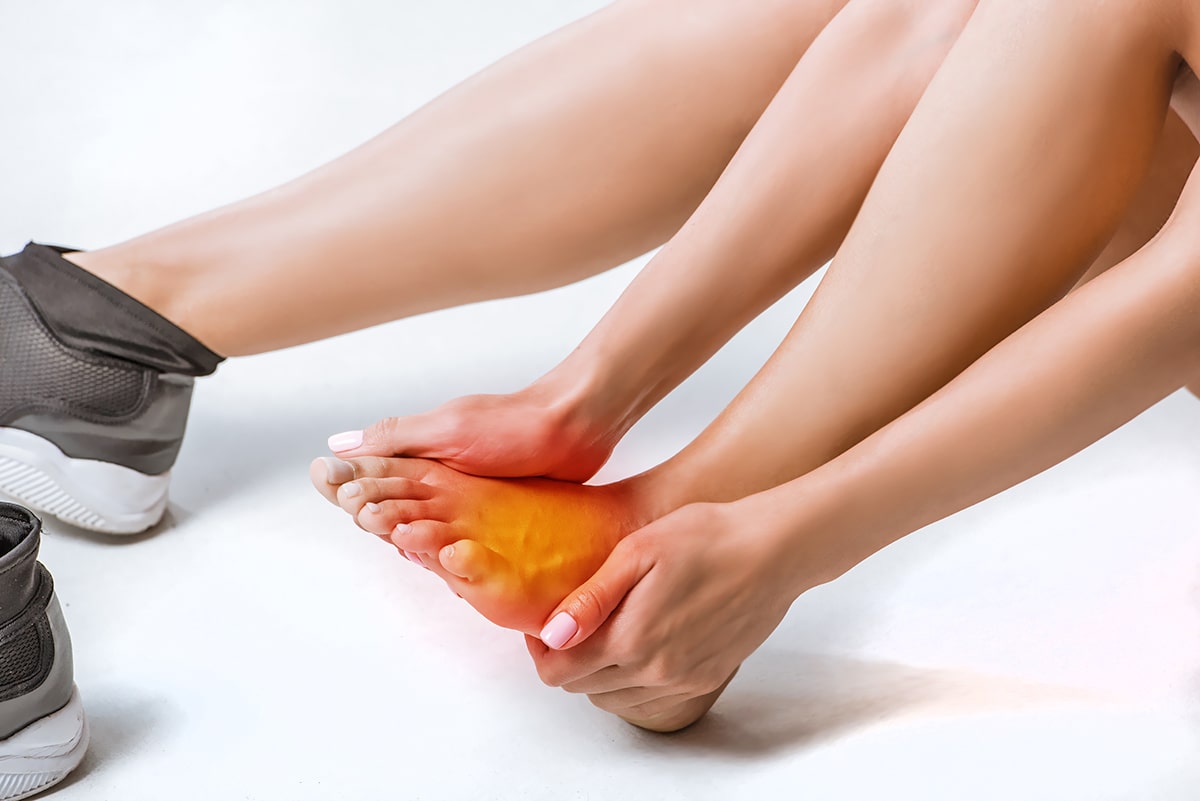FOOT PAIN AND SCIATICA
The sciatic nerve is a large nerve beginning near the base of the spine. It extends downward, traveling through the hips, buttocks, and legs. It ends in the feet near the toes. Compression of the nerve root in the lower back or lumbar area of the spine in the lower back triggers pain in the foot. The pain might radiate along the sciatic nerve all the way to your foot.
Your feet are complex structures. There are many potential reasons for foot pain. The cause originates other than the foot itself such as the pain associated with sciatica.
The pain caused by sciatica triggers in your lower back radiating down your leg till your foot. Major signs include pins and needles in your foot or leg, numbness, and muscle weakness.

WHAT IS SCIATICA?
Sciatica is nerve pain caused from an injury or irritation to the sciatic nerve. The sciatica nerve originates in your buttock or gluteal area. This is the longest as well as thickest nerve in the body. This consist of five nerve roots:
- Two lumbar spine starting from the lower back
- Three sacrums starting from the final section of the spine.
These nerve roots combine together to form a right and left sciatic nerve. The sciatic nerve runs through your hips, buttocks and down a leg, ending below the knee. It would then branch into other nerves continuing down your leg and into your foot and toes.
Sciatica nerve pain caused from an injury to a nerve leading to irritation, inflammation, pinching or compression of a nerve in your lower back.
SYMPTOMS
Primary symptom is a shooting pain along the sciatica nerve starting from the lower back radiating through the buttock, and down the back of either leg.
Other common symptoms include:
- Numbness in the leg along the sciatica nerve
- Tingling sensation (feeling like pins and needles) in the feet and toes
- The pain in the nerve ranges in severity and might be aggravated by sitting for long periods.
Foot pain accompanied with leg pain or numbness, resulting in pain in the lumbar region of the spine. Depending on the condition you might have symptoms and signs like:
- Difficulty walking tiptoed: Pain on the bottom of the foot due to the sciatic nerve’s S1 spinal nerve root. The nerve root affects the calf muscle known as the gastrocnemius muscle. This makes walking on tiptoes, raising the heel off the ground or everyday activities difficult.
- Foot drop: You experience weakness or heaviness making it challenging to flex the ankle and bring up the front of the foot. Additionally, foot drop resulting from a problem with an L5 nerve root will produce pain radiating down the outside of the calf and over the top of the foot, ending at the big toe.
- Heel walk: It limits the ability to bring the foot upward leading to numbness in the lower leg and foot. Heel walk is affected if one of the nerves connected to the sciatic nerve is pinched or compressed.

WHAT DOES SCIATICA PAIN FEEL LIKE?
Depending on the cause you usually experience sciatica pain in different ways. Sometimes it is described as sharp, shooting, or jolts of pain or as burning, electric and stabbing pain.
The pain might come and go or remain constant. The pain might be severe in your leg compared to your lower back. The pain usually worsens if you sit or stand for long periods of time or when you stand up and twist your upper body. A forced and sudden body movement such as cough or sneeze might also worsen the pain.
Sciatica affects the foot suddenly or gradually depending on the cause. Disk herniation might cause sudden pain.
WHAT ARE THE RISK FACTORS?
You are at greater risk of foot problems due to sciatica pain if you have:
- An injury/previous injury – mainly your lower back or spine
- Overweight – lead to back strains, pains and other back issues
- Lack of strong core
- Underlying medical condition such as diabetes or osteoarthritis – increase the chance of nerve damage leading to injury
- Smoke – tobacco can damage spinal tissue, weaken bones, and speed the wearing down of vertebral disks
HOW TO DIAGNOSE SCIATICA PAIN?
The podiatrist would discover the condition during your physical examination and recommend imaging and other tests to confirm. These include:
- Spinal X-rays to check for spinal fractures, disk problems, infections, tumors and bone spurs.
- Magnetic resonance imaging (MRI) or computed tomography (CT) scans provide detailed images of bone and soft tissues of your back. An MRI would also help in diagnosing pressure on a nerve, disk herniation and arthritic condition.
- Nerve conduction velocity studies or electromyography help in examining the path of electrical impulses travelling through the sciatic nerve and the response of muscles.
- Myelogram helps to determine if a vertebrae or disk is causing the pain.

WHAT PROVIDES RELIEF?
If your foot pain is related to sciatica painkillers or anti-inflammatory drugs help in providing initial relief. Home care provides quick relief such as applying a hot or cold compress to the painful area.
Devices designed to manage pain could also be used along with home care to provide relief, such as HeatTens. These provide the pain-relieving benefits of heat and Transcutaneous Electrical Nerve Stimulation (TENS) in order to treat this kind of pain. If home care therapies are not providing much relief you should consult a podiatrist. The podiatrist would diagnose the cause behind pain and also suggest a course of physiotherapy for treating the pain along with treating the underlying condition.
The treatment regime is often combined with various other treatment options such as:
- Activity modification – Avoiding certain activities that trigger sciatica pain is advised till the pressure on the nerves is reduced.
- Oral non-steroidal anti-inflammatory medications including aspirin, ibuprofen and naproxen
- Epidural injections – Doctor would advise a corticosteroid, an anti-inflammatory medicine, directly into the lower back to reduce the pain and swelling around the affected nerve roots. These provide short-time (mostly up to three months) pain relief.
- Low-impact exercises – such as aerobic exercises including walking, swimming, water aerobics
- Stretching techniques – The podiatrist would include stretching exercises to improve muscle flexibility.
- Alternative Therapies – These would include spine manipulation by a podiatrist, yoga or acupuncture. Massage would help relieve muscle spasms that often occur along with sciatica.
- Surgery is considered to address the problem when these conservative approaches to managing sciatica fail.
Some of the surgical methods include:
- Microdiscectomy: It is a minimally invasive procedure to remove fragments of a herniated disk causing pressure on a nerve.
- Laminectomy: The lamina which is part of the vertebral bone that is causing pressure on the sciatic nerve is removed.
OUTLOOK
Sometimes the sources of sciatica might not be preventable, including degenerative disk disease, sciatica due to pregnancy or accidental falls. But, preventing other causes by maintaining good posture, quitting smoking, maintaining healthy weight, exercising regularly, maintaining an active life and being careful from injury or falls is necessary.
With the right treatment around 80% to 90% people with sciatica get better without surgery. Also, about half of these recover from an episode fully within six weeks.
If you or anyone you know is suffering from foot problems, our expert providers at Specialty Care Clinics will take care of your health and help you recover.
Call us on (469) 545-9983 to book an appointment with our specialists.
